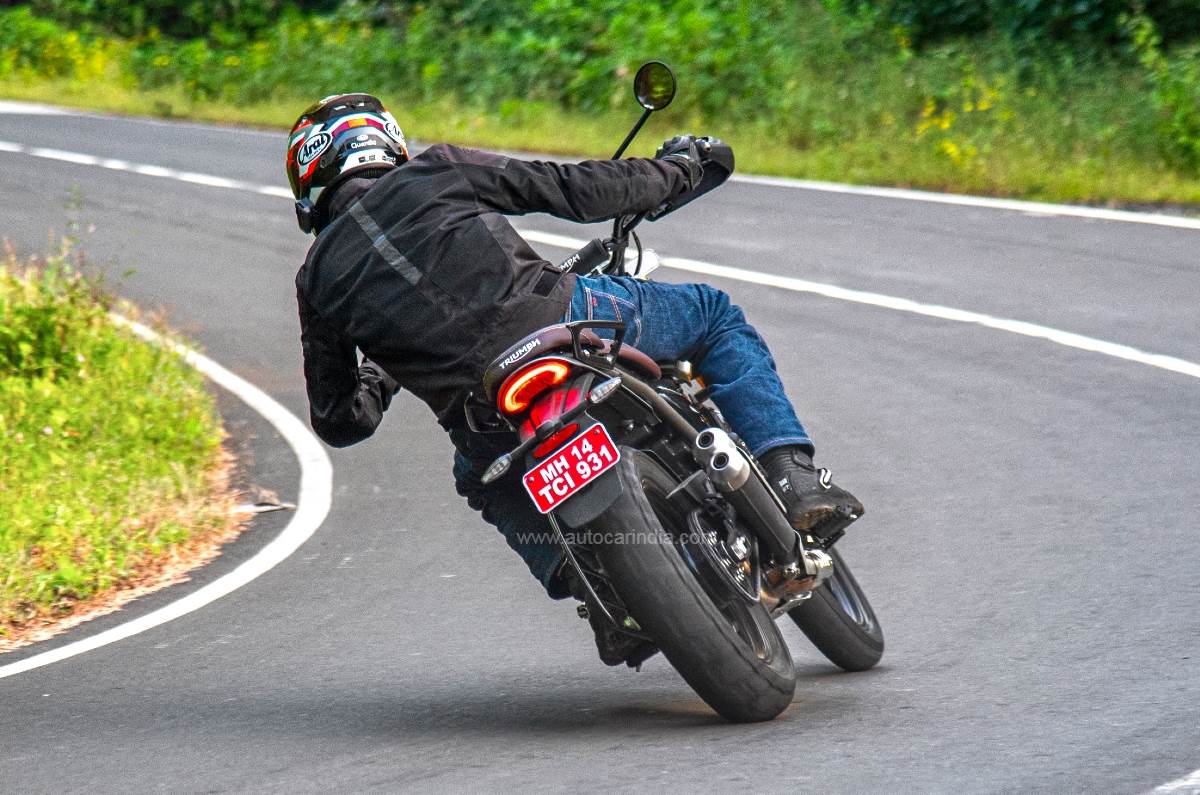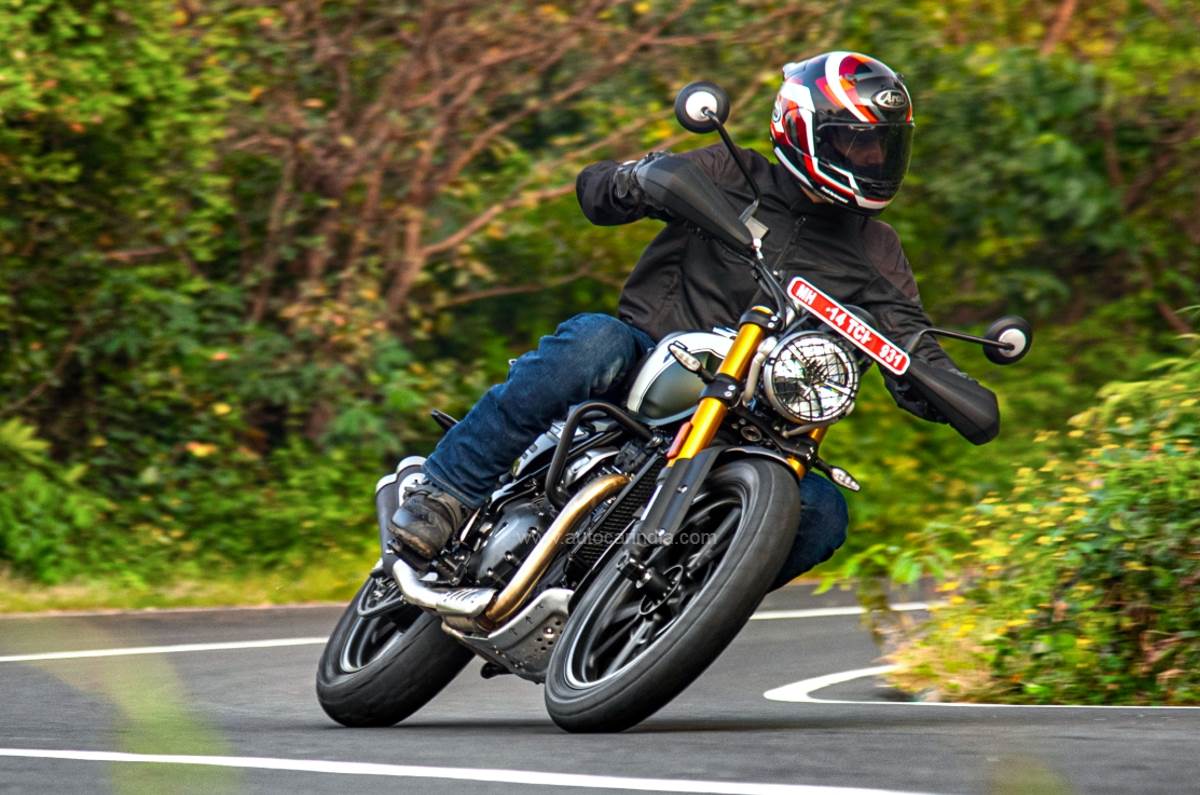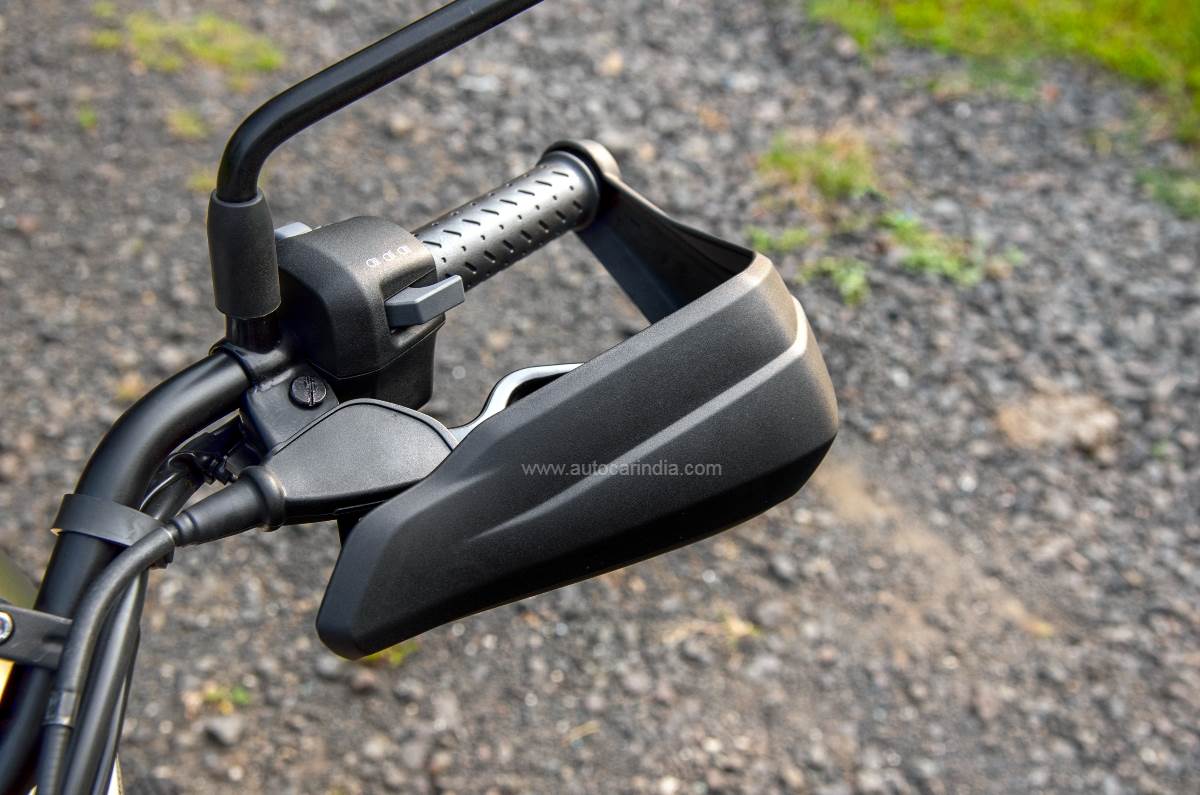Scrambler 400 X feels more different to its sibling than many would expect and it could appeal to a rather different rider.
The Speed 400 is an excellent motorcycle for numerous reasons beyond its amazing price. But the one thing that could put off potential buyers is what its sibling the Scrambler 400 X takes care of – the size.
Triumph Scrambler 400 X design, comfort
With its 19-inch front wheel and taller stance, the Scrambler 400 X not only looks bigger than the Speed but it also feels it. The sensations are due to a 45mm taller seat (now 835mm) and the wider handlebar. The rest is purely psychological because the actual width of the bike – fuel tank, chassis et al – are all the same. But you sit taller, your arms are spread out and your feet are in a more relaxed position as well thanks to slightly lower, more forward set pegs. The result is a more commanding, yet comfortable seating position that will be appreciated by larger riders and is much more conducive to long hours of riding. However, this is now a tall bike and anyone shorter than 5’8 will probably find themselves on tip toes.
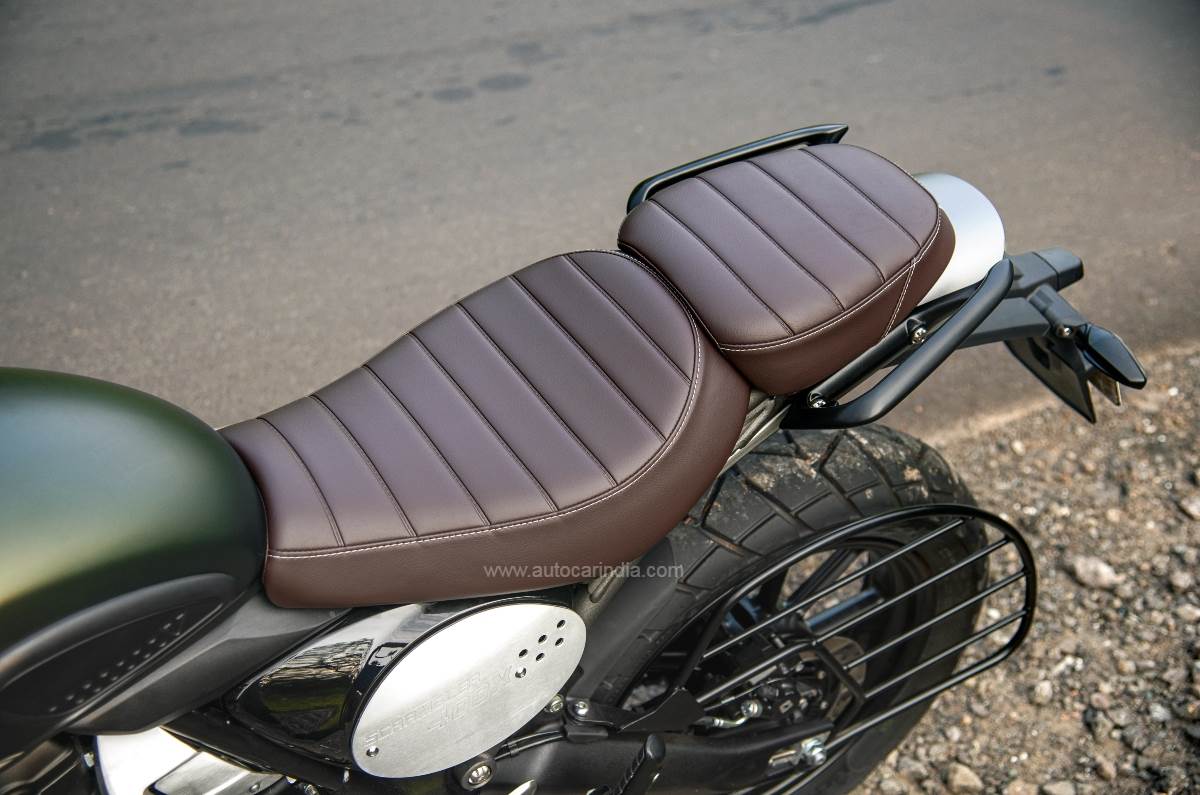
The reason the seat height has gone up is that this bike has chunkier tyres and longer travel suspension – now 150mm at both ends. Ground clearance is correspondingly up to 195mm and the spec sheet reveals that the wheelbase has increased by 40mm. Triumph hasn’t used a longer swingarm to achieve this but, instead, the chassis headstock has been lengthened, which has created the effect of a sharper rake angle. However, the 19-inch front wheel also has an offset axle which lengthens the trail, thus bringing in extra stability.
Triumph Scrambler 400 X handling, ride comfort
How does all this feel on the road? Quite a bit more different than you might expect. The 19-inch front wheel along with the chunky MRF tyres have resulted in a rather different sense of feedback from the rider. The Scrambler replaces the Speed’s light and more immediate responses for a slightly slower, more stable set of dynamics.
It is by no means a heavy or unwilling handler, and the suspension is nicely controlled on the road without any excess softness or pronounced dive under the brakes. But with a reduced sense of feedback from the larger wheel and the on/off tyres, this is more of the sort of bike where you’d want to briskly flow through the corners rather than attack them.
That being said, there’s still plenty of cornering clearance and it’ll take a good amount of work to start scraping the footpegs – I never found that point. As for the MRF tyres, they were about fine in the dry, but if you like riding at a fast pace, you’ll want something better; partly for additional grip, but mainly in terms of more feel and feedback.

The Scrambler 400X gets a larger 320mm disc to help combat the extra inertia from the bigger, heavier front wheel, although unlike the Speed, it doesn’t get sintered brake pads. Braking performance is good enough and the gentle initial bite is helpful off road. But aggressive road riders will want more and you have to put quite a lot of force into the lever to slow down in a hurry. Installing the Speed’s pads should help.
Triumph Scrambler 400 X engine performance, mileage, highway cruising
Like with the Speed 400, this bike isn’t about the bleeding edge of performance and is more about quick, effortless riding. In that respect, the engine is one of the most familiar aspects, with the same tune and internal gearing, although Triumph has given it a one tooth smaller front sprocket.
That is quite a dramatic change on what is a motorcycle that is already borderline geared too short. However, the tall and chunky rear tyre significantly increases the rear wheel rolling diameter which raises the gearing once again. Triumph says that their intention was to match the overall gearing on the Speed on paper. In reality, it more or less feels that way, but I did get the sense of an ever so slightly more relaxed feel at cruising speeds. It’s a small thing, but just another contributor towards making this a more highway appropriate motorcycle than the Speed 400.
The 398cc liquid-cooled engine doesn’t have much character or emotional connect in the way that it sounds and feels. But its performance is without question and you won’t find anything else that can give you this level of brisk performance with such low effort.
We managed to put the Scrambler 400 X through our full test cycle and its performance numbers were pretty much on par with the Speed 400. With a time of 6.92s, it was just 0.2s slower from 0-100kph than the Speed. Efficiency numbers were similar as well, with the bike returning 34.7kpl when ridden at a steady 80kph on the highway and 28.07kpl within the city.
Speaking of, in the city, that shorter gearing along with the awesome mid range and good heat management made the Speed 400 a beautifully quick and effortless bike to commute on. Much of that feeling translates to the Scrambler as well and it also feels very easy to manoeuvre – but only as long as you are comfortable with the seat height. Aside from the height, the other difference is that the wider handlebar and handguards will get in your way a bit more through tight gaps, but otherwise this is also a very nice bike for a daily commute.
Triumph Scrambler 400 X off-roading
What about the scrambling aspect then? Well, things are pretty good here too. The standing ergos are quite nice without much of a bend down to the handlebar and a nice interface between your legs and the motorcycle. The toothy metal footpegs are wider and the rubber inserts can be easily removed to give your boots more grip in wet or slushy conditions. Like the Speed, you can deactivate the traction control, but the Scrambler goes one step further in letting you deactivate the rear ABS.

Off road, this bike is far more than a poser. You have just 5mm less ground clearance than the KTM 390 Adventure and the Triumph has a much tougher feeling metal bash plate. The longer, more stable feel is welcome off road and the bike encourages you to play around, or simply go explore that interesting looking trail you noticed on the side of the road.
At 185kg, it is a lot closer to the likes of the Himalayan than the Xpulse and you do get the sense that you’re on a somewhat tall and heavy thing. However, the bigger limiting factor is the suspension. 150mm is a fair bit short on what you’ll find on a proper ADV and while this set up can take some abuse, the front warns you with an unsettling thud if you start hitting big rocks hard enough.
As your mind starts to prioritise protecting the alloys you’ll remind yourself that while this is a bike that can take you pretty far down the average trail, it’s not a bike that you should take too seriously as an off-roader.
Triumph Scrambler 400 X design, build quality
When it comes to the visual aspect, there are three unique paint schemes and it differs from the Speed in the alloy wheel design as well as in the seats and grab handles. I think this is the better looking of the two siblings and it certainly has a more substantial stance.
The headlamp grille, handguards and padded cross-braced handlebar complete the look. That being said, the handguards are plastic and will struggle to survive a fall, as I discovered when I misread a mound of mud that looked firmer than it was.

The fall was slow and I was fine. As for the bike, the side guards did well to keep the engine and fuel tank completely protected. The exhaust picked up some small scuffs, the handguard broke, as did the tip of the brake lever. The foot brake lever was absolutely fine, but the handlebar did bend a little, which was surprising. Nevertheless, I was able to ride the bike out and continue the shoot. Moreover, this sort of damage shouldn’t be too expensive to fix either, which is a good thing.
Triumph Scrambler 400 X verdict
The Scrambler 400 X is priced at Rs 2.63 lakh (ex-showroom, Delhi), which is about Rs 30,000 more than the Speed 400 and still represents amazing value. Its closest rival would be the 390 Adventure, which starts at Rs 2.80 lakh for the base X variant, while the top-spoked wheel version costs a lakh more than the Triumph.
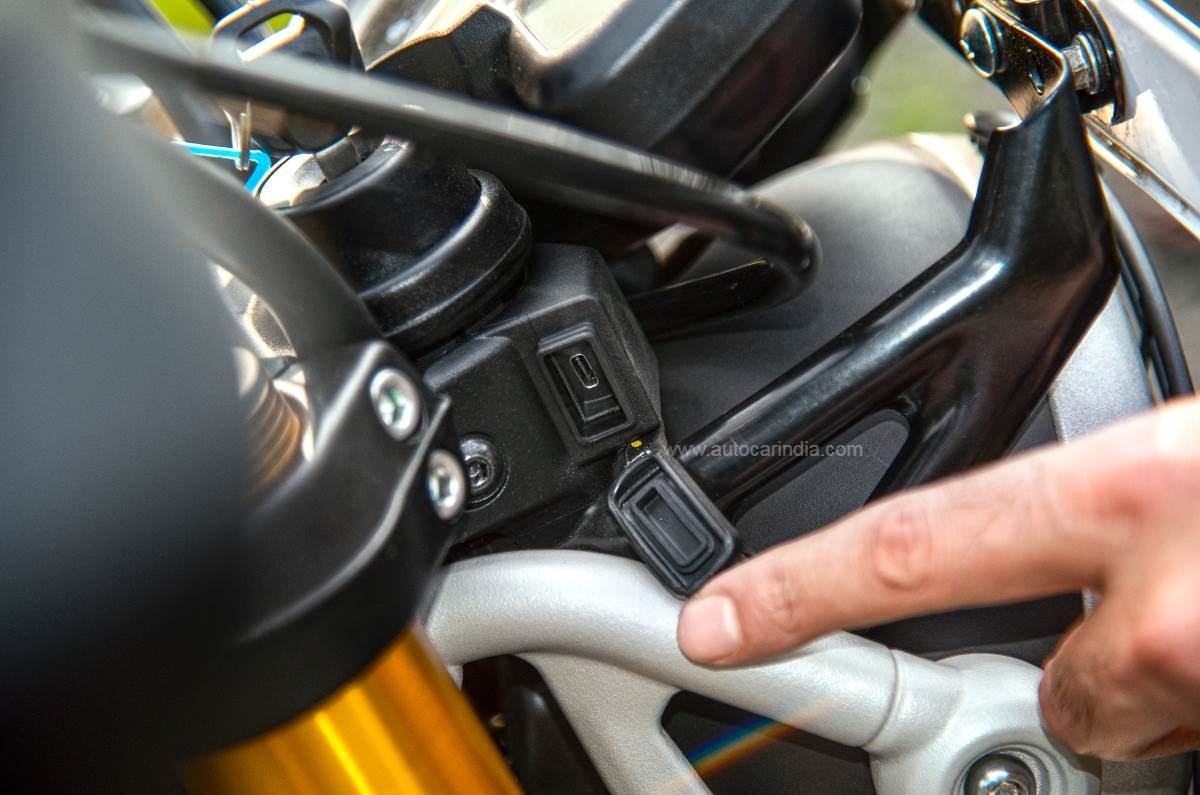
Mainly, it’s great to see the extent to which Triumph has gone to distinguish this bike from its sibling and it will appeal much more to larger riders, or those who wish to take their bikes out of the city on a more frequent basis. This package and pricing will surely give Royal Enfield a lot to think about when it comes to pricing their upcoming Himalayan 452.





















